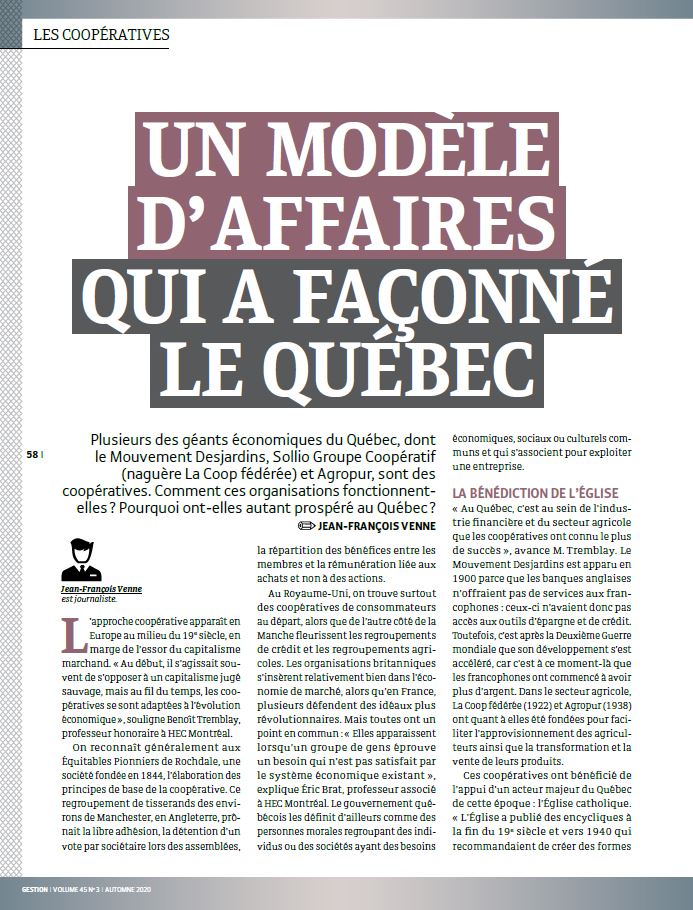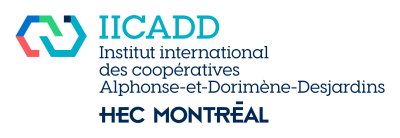
September 11, 2020
The Institute’s Director and Associate Professor, Éric Brat, and Benoît Tremblay, Honorary Professor at HEC Montréal, were interviewed as part of a special feature on the cooperative model in the magazine Gestion HEC Montréal.
The first article, entitled “A business model that shaped Quebec”, presents a portrait of the development of cooperatives from early days, beginning with the Rochdale Society of Equitable Pioneers, a society founded in 1844 in England generally recognized for having developed the basic principles of the cooperative. At the time, underlines Benoît Tremblay, “(…) it was often about opposing a capitalism considered wild, but over time, cooperatives adapted to economic development”. Although at the time cooperatives in the United Kingdom were often consumer cooperatives, and those in France, credit and agricultural groups, they are all similar in one important respect, according to Éric Brat: “They appear when a group of people have a need that isn’t met by the existing economic system”.
In Quebec, the model took root in 1900, with the Desjardins Group. In the province, it is indeed “within the financial industry and the agricultural sector that cooperatives have been most successful”, according to Benoît Tremblay. Not only thanks to the Catholic Church, which encourages the creation of associations between people to help working classes escape poverty, but also gradually with the support of the State, which adopted laws favorable to the development of cooperative entities. In fact, over the 1960s and 1970s, the State saw the cooperative model as a tool helping Francophones regain control of their economy, in a country still largely dominated by Anglophone institutions. This decisive support led to a real boom in cooperative businesses in Quebec – there are 3,300 cooperatives and mutuals, bringing together 8.8 million producers, consumers and workers – as well as strong growth – today, the Desjardins Group manages $313 billion in assets, while La Coop fédérée, renamed Sollio Groupe Coopératif in February 2020, is the largest agricultural cooperative in Canada.
Although cooperatives are democratic institutions – one member, one vote – they remain commercial, that is, for-profit entities. “These are not non-profit organizations. They must be profitable and operate in a competitive environment”, notes Éric Brat. This model is beneficial for the economic health of the country: these institutions’ significant territorial anchoring constitutes “(…) a strong cooperative economic fabric (which offers) a guarantee of stability and well-being for employees and consumers”, he concludes.
The article “Is the cooperative spirit still relevant?” explores the expansion of the cooperative model in areas and sectors other than financial services. Although the model suffers from a lack of visibility, the interest of young Quebecers (18-34 years) is high. By citing a study carried out in 2019 by the Institute, as well as a survey conducted in 2017 by the firm Léger, the article shows that young people share fundamental values anchored at the heart of the cooperative model, but without associating them with this model. “(They) know these companies very well but don’t always realize that they are cooperatives,” notes Éric Brat.
Explaining and promoting this business model is one of the main objectives of the Institute through the CoopGateway platform. It is currently the world’s largest library of cooperatives and mutuals, gathering data from around the world and facilitating access to it, especially for researchers. “Finding data on cooperatives in Quebec remains a challenge and (the) CoopGateway represents an asset to overcome it,” underlines Benoît Tremblay.
Over the years, new laws and amendments have allowed and encouraged the adoption of the cooperative model to a growing number of individuals from increasingly disparate fields.
The article examines four cooperatives in architecture, engineering, electricity, and books, exploring their adaptation to the model, as well as their entrepreneurial vision.
